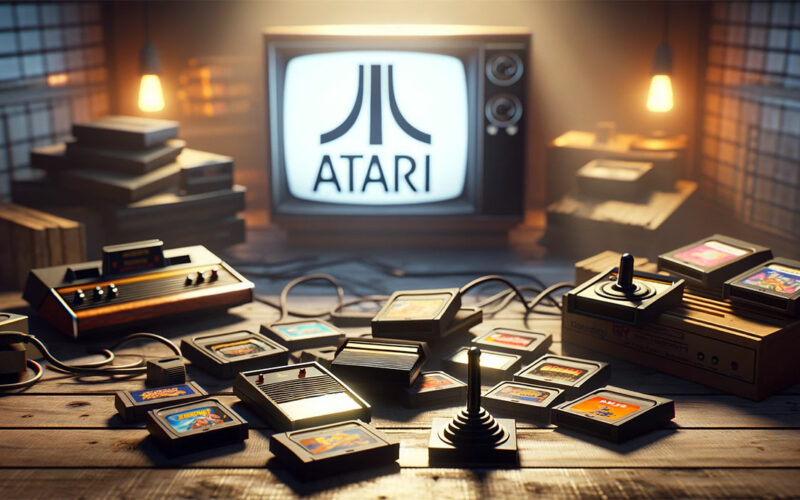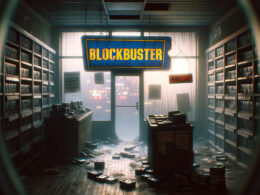Gaming’s Lost Gem: What Happened to Atari?

So, check it out. Picture a world where arcades are king, right? Two dudes, Nolan Bushnell and Ted Dabney, got together and sparked a revolution that would light up the ’70s like a disco ball.
These guys had the guts to start Atari, and boy, did it take off. It all started with Pong – you know, that simple tennis-like game that became the granddaddy of all arcade games. It wasn’t just a hit; it was like that catchy tune you can’t get out of your head, making Atari the name on everybody’s lips.
Now, let’s talk about the big shot, the Atari 2600 console. This bad boy was like the golden ticket for Atari, turning basements into arcades and bringing that electric buzz right into the living room.
With cartridges that let you switch up games, it was a never-ending party. And those games! Man, they weren’t just games; they were cultural icons, defining what cool was for a whole generation. From the get-go, it was clear – Atari wasn’t playing around; they were making history.
The Golden Age of Atari
Expansion and Innovation
So, Atari’s riding this massive wave, right? And they’re not just sitting back; they’re pushing the envelope, cranking out new consoles and games that have folks queueing up around the block.
This wasn’t just about playing it safe; this was bold moves and big ideas. And here’s a twist – they even had Steve Jobs on the payroll before he hit the big time with Apple. Talk about spotting talent!
Market Domination
It was like Atari had the Midas touch – everything they touched turned to gold. We’re talking peak market share here, the kind of domination that has other companies eating your dust.
They weren’t just a part of the gaming industry; they were the gaming industry, shaping how we played and interacted with digital entertainment.
And this wasn’t just about games; it was about being at the center of a cultural shift that had Atari sitting pretty as the king of the hill.
The Downfall of Atari

The Video Game Crash of 1983
So, rewind to ’83, and it’s like the whole scene took a nosedive. We’ve got this video game crash, right? It’s a mess.
A total overload of consoles and games just flooding the market. And Atari? They’re in the thick of it. They pushed out so much gear that stores couldn’t keep up. Shelves are groaning under the weight of unsold cartridges.
Then boom – E.T. the Extra-Terrestrial game drops. Hyped to be the next big thing, it ended up as the flop heard ’round the world.
They say they buried loads of unsold copies in a desert because no one wanted them. Talk about an “ouch” moment for Atari. That disaster became the stuff of legends – a symbol of what went so wrong.
Business Missteps
And it’s not just one bad game. It’s a whole bunch of stuff piling up. Like, they’re churning out games so fast, they forgot to check if they’re any good. Quality control took a vacation, and it shows. Customers are peeping the scene, and they’re not impressed.
On the flip side, the head honchos are making some wacky calls. Their strategies? Out of whack. Leadership? It’s like they’re reading a map upside down, and it doesn’t help that they’re passing the CEO hat around like it’s a game of hot potato.
The Split and Sale of Atari
Divestment by Warner Communications
Fast forward a little, and Warner Communications, the bigwig owner, has had enough. They’re cutting their losses.
The word “divestment” is thrown around, and next thing you know, Atari’s split faster than a wishbone. Now we’ve got two Ataris: the Atari Corporation and Atari Games.
And then enters Jack Tramiel, the Commodore guy. He scoops up the Atari Corporation, and man, he’s shaking things up. But it’s not all smooth sailing; the seas are rough for Atari in these waters.
The Aftermath of the Split
The aftermath? It’s a tale of two cities. The Atari Corporation? Let’s just say it’s seen better days. They’re trying to get back on the horse, but the horse keeps on bucking.
Meanwhile, Atari Games is doing its thing, staying afloat. It’s weird, they’re under the same name but marching to the beat of their own drums. The gaming world’s still spinning, and Atari’s trying to keep pace, but that golden age? Seems like it’s on the other side of the horizon, with Atari’s influence fading faster than a sunset.
Atari’s Attempts at Revival
The Later Consoles
Alright, let’s get into the comeback kid vibes Atari was going for. They dropped the Atari Jaguar, aiming to claw back into the game.
But man, it was like showing up to a 4K ultra HD party with a tube TV. The Jaguar had some cool ideas but getting hands on one felt like finding a unicorn.
Plus, it was up against giants like PlayStation and Xbox, who were already throwing haymakers in the graphics and gameplay department.
So, Atari decides, “Hey, let’s pivot.” And they step away from the console wars, waving the white flag to the hardware hustle. It’s a whole new world, and they’re looking for their spot in it.
Modern-Day Atari
Fast forward a bit, and Infogrames, this French company, swoops in. They’re like, “We see you, Atari, and we got plans.” So they snag it, slap on a fresh coat of paint, and Atari’s back in the game, sorta.
They’re juggling nostalgia and new tech with the Atari VCS and even a nod to the past with the Atari 2600+. It’s a mixtape of old-school beats with a modern twist, trying to capture hearts all over again.
The Legacy of Atari
Influence on Modern Gaming
Now, let’s talk influence. Everyone who’s anyone in gaming’s taken a page from Atari’s book.
They stumbled hard with quality control, sure, but it taught the industry a hefty lesson about not rushing the cooking time on games. And their swag?
It’s in the DNA of game development now, from pixel art to platforming.
Cultural Impact
And get this, Atari wasn’t just about games. They were Silicon Valley before Silicon Valley was cool. Talk about a trendsetter.
Plus, they’re like the godfather of the retro gaming movement. You see an Atari joystick, and it’s like hopping in a time machine, straight back to when hair was big and arcades were king.
FAQ On What Happened To Atari
Why did Atari crash in 1983?
You ever heard about putting all your eggs in one basket, right? Well, Atari did just that. They thought they had the golden goose with their game “E.T.,” but man, it bombed. Hard.
They made too many cartridges, and guess what? No one bought them. So, there they were, stuck with a bunch of unsellable plastic and a massive hit to their rep. The whole industry felt the sting, and it was game over for Atari’s glory days.
What led to the fall of Atari after dominating the market?
It’s like this – Atari was the king of the hill, but they got cocky. They started churning out games without worrying about quality. People weren’t fooled, though; they could tell a rushed job from a mile off.
The market got flooded with mediocre games, and folks just stopped trusting the Atari badge. Plus, competition started creeping up, ready to take a slice of the pie.
Was the E.T. game really that bad?
Oh, E.T. was a disaster, a real facepalm moment. They pushed it out way too fast, trying to cash in on the movie’s hype. But the game? It was confusing, full of bugs, and just no fun.
Even die-hard fans felt let down. It wasn’t just bad; it was a legend for all the wrong reasons. It’s like, they accidentally dug a hole for themselves, just like E.T. in the game.
How did the video game crash of 1983 affect Atari?
Imagine you’re running a race, leading, and then you trip and bring everyone down with you – that was Atari in ’83. Their mistakes didn’t just hurt their own sales; they shook the whole industry’s confidence.
Prices plunged, companies went under, and the video game future looked bleak. Atari’s blunders had everyone questioning if video games were just a fad.
Why did Warner Communications sell Atari?
Warner had big dreams for Atari, but when things got rocky, they bailed. They saw the crash, the losses, and figured they were better off cutting their losses. So, they split Atari into two and sold the home console part to Jack Tramiel. Warner just wasn’t up for weathering the storm.
What happened to Atari after the split?
So, post-split, Atari was like a band that broke up but both tried to keep singing the hits. The Tramiel-led Atari Corporation tried to make a comeback with computers and the Lynx handheld, while Atari Games kept on with arcade hits.
But let’s be real, it wasn’t the same. They lost the magic, and eventually, both parts faded out, swallowed up by the big fish in the tech pond.
Did Atari ever make a successful comeback?
Well, “successful” is stretching it. They gave it a shot with the Jaguar console, but by then, the game had changed, and they couldn’t keep up with the likes of Sony and Nintendo. It was too little, too late. The Jaguar just couldn’t pounce far enough to make a dent.
What is Atari doing now?
These days, Atari’s trying to ride the nostalgia wave. They’ve got their name on mobile games and even a new console, the Atari VCS. They’re also dipping their toes in fashion and other quirky ventures. They’re not the titan they once were, but they’re hustling, trying to stay in the game.
How did the downfall of Atari affect the gaming industry?
When Atari stumbled, the whole gaming industry felt the earthquake. It led to a total reset. Quality control became the new mantra, and the North American market got wary of home consoles for a while.
But hey, it also cleared the stage for the next-gen consoles to rise, setting the scene for Nintendo and Sega to eventually step up.
What lessons were learned from Atari’s downfall?
If the Atari saga taught us anything, it’s to never take success for granted. Quality is king, and if you ignore your customers, you’re heading for a fall. It also showed the industry that innovation is critical, but so is sustainability.
You can’t just keep pumping out the same old formula and expect people to keep paying up.
Conclusion On What Happened To Atari
So, here’s the scoop on where things are heading. Atari’s got some new bosses in the house, and they’re not just sitting around playing “Breakout” on repeat. They’ve got plans, big ones, like strategic moonshots that could put them back on the map. Think bold moves, not just rehashing the old ‘blast from the past’ thing.
They’re talking new products, stuff that’s not just a rerun of their greatest hits. And it’s not all talk; they’re putting the pieces together, trying to be the comeback kid in a market that’s got more players than a Battle Royale. Let’s just say, they’re not throwing in the towel.
Despite the rollercoaster, the Atari vibe? It’s still kicking around. Like that one band from your parents’ vinyl collection that just keeps on touring. Their brand’s got some serious staying power, showing up in places from fashion to flicks. It’s got that classic cool that doesn’t just fade away.
Talking about the here and now, Atari’s jockeying for a spot in the industry once more. Not at the high table maybe, but definitely in the room. And their legacy? It’s like the roots of a massive oak in gaming’s backyard. What happened to Atari isn’t just a history lesson; it’s a roadmap of do’s and don’ts for every game developer out there.
If you liked this article about what happened to Atari, you should check out this article about what happened to Kodak.
There are also similar articles discussing what happened to Saab, what happened to Sports Authority, what happened to Newsweek, and what happened to JCPenney.
And let’s not forget about articles on what happened to Sun Microsystems, what happened to Woolworths, what happened to RadioShack, and what happened to Virgin America.
- Unlocking Efficiency: Top CSS Generators To Try - May 4, 2024
- What Is Rust Used For? A Guide to Its Applications - May 4, 2024
- Simplifying Video Editing: Creative Apps Like Kapwing - May 3, 2024








